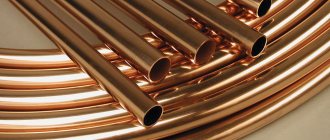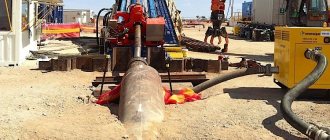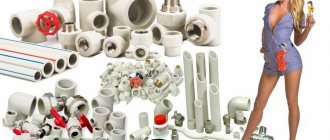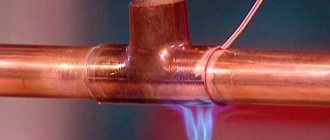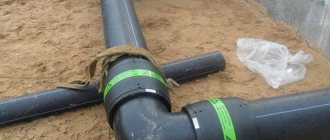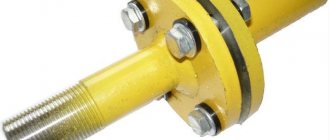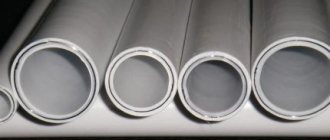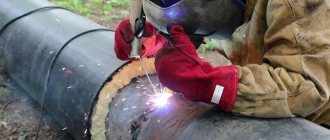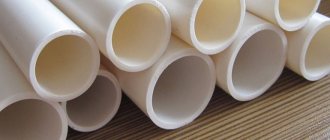Pipe bending methods without factory equipment
In domestic conditions, there is often a need to bend pipe blanks when carrying out construction work or installing gas pipelines. At the same time, it is not economically feasible to spend financial resources on purchasing factory pipe benders for one-time operations; many use simple homemade devices for these purposes.
Steel pipes
Steel is a fairly rigid and durable material that is very difficult to deform; the main method of changing its configuration is bending in a heated state with a filler under simultaneous physical impact. For thin-walled stainless steel pipes, the following technology is used to obtain a long section with a small bend radius:
- Place the workpiece vertically, close it at one end with a stopper and pour very fine dry sand inside; after it is completely filled, insert the stopper on the other side.
- Find a pipe or low vertical pole of the required diameter and firmly fix the pipe end to its surface.
- Wrap the part around the pipe axis, turning the template or walking around it.
- After winding, the end is released and the curved part is removed from the template, the plugs are removed and sand is poured out.
Rice. 11 How to obtain the required bending radius of a copper pipe
Copper pipes
Copper is a softer material than steel; it is also convenient to bend when heated or with the help of sand poured inside. You can also use a household mandrel substitute for bending - a steel spring with dense thick coils and a cross-section slightly smaller than the workpiece. When carrying out work, the element is inserted inside and located at the point where deformation occurs, and after the necessary operations it is easily removed out. But it is much easier to bend copper pipes with a special spring pipe bender (these products can be purchased at the retail chain), which are effective on short routes and work due to the uniform distribution of the applied force on the surface. The spring device works as follows:
- The spring is placed over the pipe in the desired place, after which it is manually bent along with the pipe.
- With further bending, the spring is moved and bent at another point.
- Upon completion of the operation, the spring segment is easily removed without the use of auxiliary means.
Another popular material is aluminum, which is easier to bend when heated with a torch.
Rice. 12 How to bend pipes without an aluminum machine
Metal-plastic pipes
When bending metal-plastic pipes in households, an internal or external spring (conductor) is used. The technology for carrying out the work is similar to operations with a copper pipe; when bending, the permissible radius restrictions must be observed to avoid damage to the product.
Plastic pipes
The main element for changing the configuration of plastic pipes is a construction or household hair dryer; sand can be used to facilitate the work. Products of complex shape are bent as follows:
- Self-tapping screws are screwed onto a wooden plate using a screwdriver according to the desired configuration of the workpiece.
- The pipe end is inserted between two screws and the pipe wall is heated with a hairdryer, ensuring the direction of the product with turns and flexibility along a given route.
- At the end of the work, unscrew the screws and remove the workpiece.
Rice. 13 Methods for bending metal-plastic pipes using external and internal conductors
You can use another simple technology:
- Pour sand into a plastic pipe and tightly close its ends.
- Place the product in boiling water for a while and then remove it to the surface.
- Give the workpiece the desired shape, fixing it in the desired position and waiting for cooling.
Rice. 14 How plastic elements are bent
Existing industrial and household methods for obtaining the required bending radius make it possible to carry out these operations with any materials of various diameters. To carry out the work, special devices of a manual or electromechanical operating principle are used, which often use hydraulic units. In households, effective bending methods are the use of special springs and heating of products with gas burners or a household hair dryer (when bending plastic).
How to bend a copper pipe at home
There are several methods to increase the strength characteristics of non-ferrous metal. One of them can always be used when deciding how to bend copper tubes at home without using a complex special tool.
Temperature method
Heating allows you to bend the copper pipe as easily as possible. This process is performed using a gas burner. At home, a blowtorch is also often used. However, heated metal can easily deform, and a wavy area with a less durable structure will appear on its surface. The reason for this is the high thermal expansion of the material when significant temperature fluctuations occur.
Using a burner.
The risk of deformation during heating increases with increasing pipe size. Therefore, this method is most effective when bending rolled copper with thin walls. This is the material most often used in residential buildings.
Using sand
Sand also helps to bend copper pipes efficiently. The work uses river sifted dry bulk material. It allows you to maintain the shape of the product when bending it. Even if great physical force is applied during the process, the pipe will not break.
The operation is carried out as follows:
- one end of the rental is plugged with a wooden plug using a mallet;
- the internal cavity of the product is completely filled with bulk material, which is compacted by tapping the end of the pipe with a plug on any hard surface;
- the second end of the product is closed with the same wooden plug;
- the required location is heated by uniform rotation of the pipe roll.
At the end, the product is pressed against the support and bent in the desired direction. After this, the workpiece should cool naturally. You can also use cold water.
This option is distinguished by the possibility of straightening the part if an uneven bend is obtained. In the process, you need to use a hammer, with which you need to tap the place where the defect occurred. At the end of the procedure, after the workpiece has cooled, the wooden plugs are removed from its ends and the bulk material is poured out. Before using the curved element, it must be thoroughly rinsed with clean water.
Spiral method
When installing a heating system or refrigeration system project, in some cases, the pipe needs to be shaped into a spiral. To do this, select a cylindrical template of the required diameter. Then the rolled pipe is filled with sand, and its ends are closed with plugs. Then one end of the part is fixed, and the rest of the product is heated to the desired temperature. At the end, the workpiece is bent around the template, controlling the required distance between the turns of the created spiral.
Copper spiral.
Copper pipe products are deformed in accordance with GOST 617-90. The regulatory document regulates the minimum bending radius of a copper pipe. If the outer diameter of the product is less than 10 mm, then the deformation angle should not exceed 20°. When the cross-sectional radius of the part is greater than 6 mm, the standard bending angle is up to 24°.
GOST 17365-71 Handbook on cold stamping
The minimum pipe bending radii R must be:
- for pipes with an outer diameter of up to 20 mm, not less than...2.5D
- for pipes with an outer diameter over 20 mm, not less than...3.5D (where D is the outer diameter of the pipe).
The thinning of the walls in places where pipes bend and where curved sections transition into straight ones should not exceed:
- for steel pipes – 20% of the original wall thickness
- for aluminum alloy pipes – 25% of the original wall thickness.
The thinning of the walls of pipes stamped from sheets should not exceed 15% of the original sheet thickness.
Smallest bend radius
Bending radii along the pipe axis. Bending without filling or melting. For smaller bending radii, bending should be done with reflow or filling.
Designations: D—pipe diameter; S - pipe wall thickness
To contents
The smallest radii and shortest lengths of straight sections of curved pipes are shown in Fig. 1.
The length of the curved section of pipe A is determined by the formula:
Where R is the smallest bending radius, mm; dн – outer diameter of pipes, mm.
When choosing a bend radius, you should prefer to bend pipes in a cold state whenever possible.
The shortest length of a straight pipe section Lmin is necessary to clamp the end of the pipe when bending
Bending radii of copper and brass pipes manufactured according to GOST 617-90 and GOST 494-90, respectively (see Fig. 1)
Outer diameter dн
Smallest bend radius R
Minimum length of straight section Lmin
Bending radii of steel water and gas pipes manufactured according to GOST 3262-75 (see Fig. 1)
Nominal diameter Dy
Outer diameter dн
Smallest bend radius R
Minimum length of straight section Lmin
Hot
Cold
Bending radii of steel pipes depending on their diameter and wall thickness Dimensions, mm
Pipe diameter, d
Smallest bending radius for wall thickness
IN AND. Anuriev, Handbook of mechanical engineering designer, volume 3, pp. 368-369., Moscow 2001
e = . 100, w
where Dmox is the maximum diameter at the bending point, mm;
В min — minimum diameter at the bending point, mm;
IN NO. — nominal diameter at the bending point, mm.
The percentage thinning of the minimum pipe wall thickness (&) is calculated using the formula,
where is the wall thickness along the outer part of the bend, mm;
Shom—nominal wall thickness, mm.
Berezovka. Printing house. Zzk. hi 37-3000
|Ish. N" mean. 1_Signature and dago >In return. ina. Ht Ii.” Ht dubya. Signature and date
Permissible deviations when bending pipes according to the ovality of the cross-section are given in table. 5, according to thinning in table. IN.
Section ovality, %, no more
Nominal wall thickness, mm
Allowable wall thinning in relation to the nominal thickness,%> no more
Note: The reduction in the nominal wall thickness at the bending site should not exceed the sum of the tolerances: minus tolerance according to the standards specified in the introductory part, and thinning during bending - according to Table 6.
2.4. In places where pipes are bent, corrugations are allowed in height, mm, no more than:
2 - for pipe diameters up to 25 mm;
3 - with a pipe diameter of 25-60 w;
4 - with a pipe diameter of 60-100 mm:
5 - with a sales pipe diameter of 100 mm.
2.5. Cracks, stains, flaws, sinkholes and sunsets are not allowed on the surface of the pipes.
Individual minor nicks are allowed; scale does not interfere with the inspection of dents, risks and traces of cleaning defects, if
Berezovka. Printing house. Zach. M 37-3000
How to calculate the minimum allowable radius
The minimum pipe bending radius at which a critical degree of deformation appears determines the ratio:
- Rmin means the minimum possible bending radius of the product;
- S indicates the thickness of the pipeline (in mm).
Therefore, the radius along the middle pipe axis is equal to: R=Rmin+0.5∙Dn. Here Dn means the nominal diameter of the round rod.
A prerequisite for correctly calculating the minimum bending radius is the need to take into account the ratio:
- Kt means the coefficient of thinness of products;
- D indicates the outer diameter of the pipes.
Therefore, the universal formula for calculating the minimum permissible bending radius is:
When the given radius is greater than the value obtained from the above formula, then the cold pipe bending method
. If it is less than the calculated value, the material should be preheated. Otherwise, its walls will become deformed when bending.
- Then the minimum permissible bending radius of a hollow rod, without the use of a special tool, should be: R ≥9.25∙((0.2-Kt)∙0.5).
- When the minimum bending radius is less than the calculated value, then the use of a mandrel is mandatory.
The correction to the bending radius of pipes after removing the load, taking into account springing (straightening inertia), is calculated by the formula:
- Do means the section of the mandrel;
- Ki is the coefficient of elastic deformation for a specific material (according to the reference book).
- For an approximate calculation of elastic deformation for a steel or copper pipe with a passage of up to 4 cm, a coefficient value of 1.02 is accepted.
- For analogues with an internal diameter greater than 4 cm, this figure will be equal to 1.014.
To know exactly the angle at which the material should be bent, taking into account the radius of gyration of the pipe, the formula is used:
- ∆c is the rotation angle of the median axis;
- Ki is the springing coefficient according to the reference book.
When the desired radius is 2-3 times larger than the cross-section of the hollow rod, a spring coefficient of 40-60 is taken.
Watch the video
Calculation of pipe bending radius using a ruler
To carry out the calculations, you need to take two rigid rulers 30 and 50 cm long. Initially, the bending radius of the already bent pipe is measured, which must be repeated on the workpiece. The ruler must be applied to the original pipe and the distance between the ruler and the middle of the pipe must be measured (Fig. 1).
Rice. 1 Measure the width in the original pipe.
Using the obtained ruler measurement data, it is necessary to select suitable parameters for the radius and diameter of the arc from tables 1 and 2.
D – arc diameter, mm
Table 1. Using a 30 cm ruler
| Interval | 5 | 7,5 | 10 | 12,5 | 15 | 17,5 | 20 | 25 |
| Diameter | 4505 | 3008 | 2260 | 1813 | 1515 | 1303 | 1145 | 925 |
| Radius | 2253 | 1504 | 1130 | 907 | 758 | 652 | 573 | 463 |
| Interval | 30 | 40 | 50 | 60 | 70 | 90 | 100 |
| Diameter | 780 | 603 | 500 | 435 | 391 | 340 | 325 |
| Radius | 390 | 302 | 250 | 218 | 196 | 170 | 163 |
Table 2. Using a 50 cm ruler
| Interval | 5 | 7,5 | 10 | 12,5 | 15 | 17,5 | 20 | 25 | 30 | 40 | 50 |
| Diameter | 12500 | 8341 | 6260 | 5013 | 4182 | 3589 | 3145 | 2525 | 2113 | 1603 | 1300 |
| Radius | 6250 | 4172 | 3130 | 2507 | 2091 | 1795 | 1573 | 1263 | 1057 | 802 | 650 |
| Interval | 60 | 70 | 80 | 90 | 100 | 110 | 130 | 160 | 200 |
| Diameter | 1102 | 963 | 861 | 785 | 725 | 678 | 611 | 550 | 513 |
| radius | 551 | 482 | 432 | 393 | 363 | 339 | 306 | 275 | 257 |
Pipe bending radius for devices used in everyday life and industry
On the construction market you can find a large number of devices for individual use for bending pipes, from simple springs to complex electromechanical machines with hydraulic feed.
Manual pipe benders
Pipe benders of this class are low cost, have a simple design, low weight and dimensions; the process of bending the workpiece occurs due to the physical effort of the worker. Based on the principle of operation, manual units produced by industry can be divided into the following categories.
Lever. Bending is achieved through a large lever, which reduces the applied muscle force. In such devices, a workpiece is inserted into a mandrel of a given shape and size (punch) and, using a lever, the product bends around a template surface - the result is an element of a given profile. Lever devices allow a 180-degree radius of curvature and are suitable for small diameter soft metal pipes (up to 1 inch). To obtain curves of various sizes, replaceable punches are used; to facilitate work, many models are equipped with a hydraulic drive.
Rice. 7 Hand-held crossbow devices
Crossbow. During operation, the workpiece is placed on two rollers or stops, and bending occurs by applying pressure to its surface between the stops of a punch of a given shape and cross-section. The units have replaceable punch attachments and movable stops that allow you to set the bending radius of a steel pipe or non-ferrous metal workpieces.
The bending shoe is mounted on a rod, which can be moved by a helical gear, hydraulic fluid pressure when manually pumping, or by electrically driven hydraulics. Such devices allow bending of pipes made of soft materials with a diameter of up to 100 mm.
Three-roller units (pipe bending rollers). They are the most common type of pipe bending units in everyday life and industry; they operate on the principle of cold rolling. Structurally, they are made in the form of two rollers, in the grooves of which the workpiece is installed, the third roller is gradually brought to the surface, simultaneously rolling the product in different directions. As a result, the workpiece is deformed without folding into a larger cross-section than in other manual pipe benders.
A distinctive feature of the unit is the impossibility of obtaining a small radius of curvature (the usual value is 3 - 4 times the internal diameter).
All of the listed devices are mandrelless units, therefore they are ineffective when bending thin-walled products; it is also undesirable to use them when working with workpieces with a welded joint of the walls - with plastic deformation, individual sections of the seam may open.
Rice. 8 Pipe bending rollers
Electromechanical pipe benders
Electromechanical units are mainly used in industry and provide the following technological processes.
Coreless bending. The machines are used when working with workpieces, for bending radii of 3 - 4 D., they are capable of bending thick-walled pipes for the furniture and construction industries, and main pipelines. The machines have the simplest design and control compared to other types, and are characterized by small overall dimensions and weight.
Booster treatment. Units that operate using a special technology for advancing the carriage with the part using an additional unit are designed to produce complex bends without thinning the walls. They are used for the manufacture of coils of various shapes in the thermal energy, boiler and water heating industries.
Mandrel bending. Units of this type allow high-quality bending of thin-walled elements with an outer diameter of up to 120 mm. Industrial machines can be automatic or semi-automatic with numerical control.
Three-roll bending. The design is widely used for bending any metals and alloys; it is versatile: it copes well with round or rectangular profiles, corners and flat plates. The versatility of the unit is achieved by changing rolls with different types of working surfaces and sizes.
Using this unit, it is convenient to bend elements of long length with the same large radius of curvature throughout.
Rice. 9 Industrial pipe benders
Metal-plastic pipes
As metal-plastic pipes spread, many began to use them in all possible communications. They are reliable, practical, inexpensive and easy to install. But how to bend metal-plastic pipes? To do this, either simple manual labor is used (if the metal in the pipe is soft), or the bending method using a spring (discussed above). It is mandatory to fulfill the condition that the metal-plastic pipe cannot be bent more than 15 degrees for every 2 centimeters. If this parameter is neglected, the pipe may simply become unusable due to a large number of damages.
Behavior of round, square and rectangular sections, types of destruction
The thickness of the pipe walls on the outer part of the bend becomes smaller due to the fact that when stresses arise, a tensile moment appears:
- The outer wall, which has become thin, tends to bend towards the median axis of the pipe. This leads to its cross section being deformed.
- When the tensile strength of the product is exceeded, it breaks along the outer plane of bending.
How do square and rectangular profiles behave:
- Their pipe walls are subject to maximum compressive and tensile stress, both on the outer and inner bending planes.
- The material has an increased tendency to deformation; it is difficult for the master to control it.
- The profile material on the inside of the bend is prone to vertically directed expansion. At the same time, it flows horizontally along the end of the product. These stresses press down the vertically located pipe walls. In this case, the square cross section is deformed. It takes on a trapezoidal configuration.
- Rectangular and square cross-sections do not transfer clamping forces between the bending and clamping jaws well.
- The profile tends to slide along the block at the beginning of bending. At the same time, he can rub it, which leads to wear and tear of the equipment.
Behavior of a material with a round cross-section when it bends:
- The material deforms less in areas of highest stress. The places of maximum compression/stretching are located along the tangent center line to the cross section.
- The round shape allows the metal to flow evenly in all directions during bending. Thanks to this, it is easier for the master to control the deformation processes of the material.
- Thanks to the round cross-section, the pipe transfers forces well between the bending and clamping blocks.
- When bending round pipes along a radius, they practically do not slip in the tool.
Bending process
Any deformation leads to a decrease in the load-bearing capacity of the profile pipe and is accompanied by the occurrence of long-term stresses on its walls. On the inner layer, due to compression of the metal, the density increases, and on the outer part, tension, on the contrary, reduces the value of this indicator. The shape of the section also changes as expected. The combination of these factors leads to the fact that the load-bearing capacity of the structure at the bending point is noticeably reduced. This is true for a round pipe, as well as for rectangular and square pipe products. Moreover, for the last two, this phenomenon is not as pronounced as for a pipe with a round cross-section.
However, in any case, a careful approach is required to assess the degree of applied load when bending the workpiece. Then unnecessary breaks and distortions will not appear on it. From the point of view of functional purpose, this concerns, first of all, round pipes from which outlets for water supply systems are made.
Good to know! The folds formed lead to blockages, increase the resistance of the transported liquid and reduce the permeability of the working environment.
Therefore, the degree of oval deformation for a part with a diameter of up to 20 mm should not exceed 15 percent. As the diameter increases, the value of this indicator decreases to 12.5 percent. The same figures are also used when determining the optimal deflection load for a pipe with a profile cross-section, and the above diameter values refer to a circle inscribed/circumscribed in/around a rectangle(s) or square(s).
Pipe bending methods and their advantages
Pipe bending is a technology where the desired rotation in the direction of the pipeline line is created by physical impact on the workpiece, the method has the following advantages:
- Reduced metal consumption; there are no adapter flanges, couplings or pipes in the line.
- Reduced labor costs when installing pipelines compared to welded joints.
- Low hydraulic losses due to unchanged profile section.
Rice. 3 Mandrels for pipe benders
- Unchangeable structure of the metal, its physical and chemical parameters compared to welding.
- High quality sealing, the line has a uniform structure without breaks or joints.
- Aesthetic appearance of the highway
There are two main bending technologies - hot and cold, devices and methods can be divided into the following categories:
- According to the type of physical impact, the pipe bending unit can be manual or electric with a mechanical or hydraulic drive.
- By bending technology - mandrel (bent using special internal protectors), mandrelless, and rolling installations with rollers.
- By profile - installations for metal profile rectangular or round products.
Rice. 4 Hot pipe bending methods
Hot bending
This technology, popular in everyday life, is used in cases where there is no pipe bending machine or it is not possible to carry out work using a cold method; the process consists of several operations:
- The workpiece is filled with fine-grained river sand without foreign inclusions in dry form. To do this, insert a plug at one end, fill it with sand and close the hole on the other side.
- The bending point is heated to a temperature of no more than 900 degrees to avoid burnout, and the part is gradually smoothly mechanically wound around a round template.
- At the end of the process, the plugs are removed and sand is poured out of the workpiece.
Cold bending methods for round pipes
Cold methods have undeniable advantages over hot technologies: they do not damage the structure of the metal, are more productive and require less costs. The following defects occur during cold bending:
- reducing the cross-section of the pipe on the outside of the profile;
- curvature in the bend in the form of a corrugation on the inside;
- changing the profile shape at pipe bending points from round to oval.
Rice. 5 Bending metal profile blanks at home
Most often, such defects occur when thin-walled pipes are deformed, so when operating with them, an internal protector is used - a mandrel inserted into the internal cavity.
The mandrel is a device consisting of a rigid rod with movable segments on the edge of a spherical or hemispherical shape. Before work, the device is placed in the internal cavity of the workpiece so that its moving elements are located at the bending point; at the end of the procedure, the mandrel is removed from the finished element and the process is repeated.
